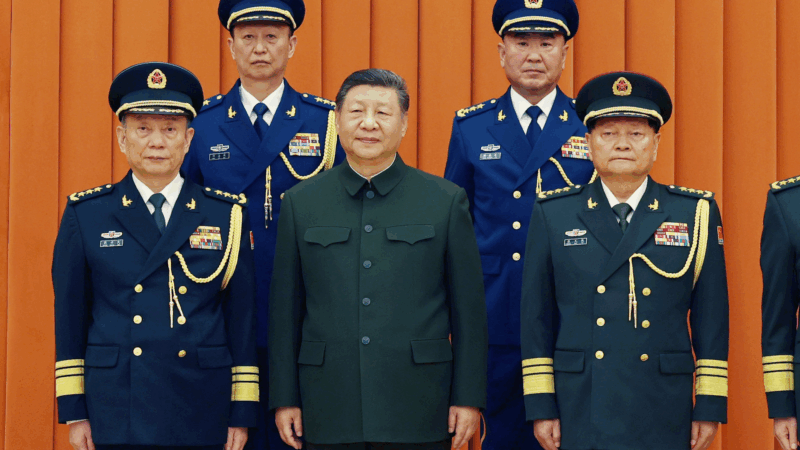Chimpanzees pick up communication styles from their moms, not their dads
Human communication is a complex weave of words and gestures — a mix of vocal and visual signals.
“People use vocal and visual communication in a very rich and combined way,” says Joseph Mine, a biologist at the University of Rennes in France.
But how and when this capacity originated is somewhat mysterious. It’s not like the emergence of human communication is visible in the fossil record — there are no gestures enrobed in amber, no syllables imprinted upon prehistoric rock.
“So there’s this big open question of how did human language evolve,” says Mine. “How did humans or hominins communicate hundreds of thousands of years ago, or even millions of years ago?”
Mine is trying to answer that question by looking to one of our closest living relatives — chimpanzees. The idea is that whatever traits humans share with chimps today could date back to when the ancestors of the two species split off from one another six million to eight million years ago.
In a study published in the journal PLOS Biology, Mine and his colleagues conclude that young chimps learn vocal and visual patterns of communication primarily from their mothers and maternal relatives. They think that this ability, which mirrors the way that young humans learn from their primary caretakers, may date back to at least that ancient moment.
Vocal gestural pairings
Mine did his field work with the Kanyawara community of roughly 60 animals in Kibale National Park in western Uganda — “a beautiful tropical rainforest where these chimpanzees live in the wild and therefore we can observe their natural behavior,” says Mine.
The individuals divvy up into subgroups that are forever splitting off and reforming, though they tend to include at least one mom and her offspring. “Anywhere between two and maybe eight or nine individuals who are all related through their mother,” he says.
Over many months, Mine and his colleagues followed the animals at a safe distance to film and record audio of them. Back in the lab, while working on his PhD at the University of Zurich, he pored over hundreds of hours of footage.
Mine searched for any vocal and non-vocal behaviors (such as facial expressions, gestures, gaze orientation, and body postures and movements) that were produced in tandem more often than expected by chance.
“They might combine a pant-hoot vocalization with running but also with slapping the ground or grabbing a branch,” he says by way of example. “Just like they might combine a soft hoo vocalization with a sitting posture and maybe an arm reach.”
In work published last fall, Mine identified a repertoire of 108 such combinations. And it was during that analysis when he noticed something curious.
“All the individuals from a certain family seem to converge around a similar number of combinations,” he says.
So he decided to dig deeper.
A lot like mom
When Mine later examined chimps ten years and older — meaning subadults and adults — he found that individuals related through their mother produced similar amounts of these vocal and visual combinations. “There is a kind of signature within the group composed of you and your mother and your maternal siblings,” says Mine.
On the paternal side, though, there was no such pattern. That is, “if your mother tends to gesticulate a lot while vocalizing, then you’re also likely to do so and your maternal siblings are also likely to do so,” he says. “But if that’s the case for your father, then you won’t necessarily show this kind of resemblance.”
A chimp spends most of its early years with its mom, not its dad. So Mine concludes that these vocal-visual combos are most likely learned. That’s because if genes were involved, the chimps would resemble both their parents.
“They don’t really have the exposure that would allow them to learn from their fathers,” says Mine. The mother, he adds, becomes a young chimp’s “social template.”
And once these behaviors are learned, they appear to stay put.
Young humans also learn to communicate from those they hang out with the most, meaning this ability may well date back at least to our last common ancestor with chimps.
“This fact that we acquire parts of our communication socially seems to be potentially a very ancient trait — a feature of our lineage for several million years,” says Mine.
Cat Hobaiter, a primatologist at the University of St. Andrews in Scotland who wasn’t involved in the research, was pleased to hear of the results. She says they provide the latest example of the way that the social world shapes primate communication.
“We’re seeing such similarities across the ape species,” she says. “My bet is that we would see something similar in gorillas and orangutans. Then we’re talking about something that might be 16, 17 million years old — so long before humans were human, apes were learning socially from each other.”
Hobaiter says future work could try to decode these combinations to figure out what they might mean — and whether these behaviors are specific to this group of animals or if they’re perhaps shared by all chimpanzees.
Transcript:
JUANA SUMMERS, HOST:
Our ability to communicate using words and gestures – how far back does that go? A new study involving chimpanzees suggests it goes back millions of years. Here’s science reporter Ari Daniel.
ARI DANIEL, BYLINE: As I talk to you right now, I’m moving my hands, adjusting my posture and facial expressions. You do it too. Human communication is a complex weave of verbal and nonverbal signals.
JOSEPH MINE: Yeah, that’s right – in a kind of very rich and combined way.
DANIEL: But how and when this capacity originated is somewhat mysterious, says Joseph Mine, currently a biologist at the University of Rennes in France. It’s not like the emergence of communication is visible in the fossil record.
MINE: There’s this big kind of open question of – how did human language evolve? How did humans or hominins communicate millions of years ago?
DANIEL: Mine is trying to answer that question by looking to one of our closest relatives – chimpanzees. The idea being, whatever traits we share with chimps today could go back to at least when our ancestors split off from one another, 6- to 8 million years ago.
(SOUNDBITE OF INSECTS CHIRPING)
DANIEL: Mine did his fieldwork here, in Kibale National Park in Uganda.
MINE: A beautiful tropical rainforest where, you know, these chimpanzees live in the wild, and therefore we can observe their natural behavior – this community of approximately 60 individuals.
(SOUNDBITE OF FOOTSTEPS CRUNCHING)
DANIEL: Over many months, Mine and his colleagues followed the animals to film and audio record them, which is what you’ve been hearing.
Back in the lab, he pored over hundreds of hours of footage. He searched for any vocal and nonvocal behaviors…
MINE: So, you know, facial expressions, gestures and body posture, and were they walking or standing or sitting?
DANIEL: …That were produced in tandem more often than expected by chance.
MINE: So they might combine a pant hoot vocalization with running, but also with slapping the ground or grabbing a branch.
(SOUNDBITE OF CHIMPANZEE SCREECHING)
DANIEL: In work published last fall, Mine identified a repertoire of 108 such combinations, but then he dug deeper. And when he examined chimps 10 years and up, he found that individuals related through their mother produce similar amounts of these combinations. On the paternal side, though, there was no such pattern. That is…
MINE: If your mother tends to gesticulate a lot while vocalizing, then you’re also likely to do so. But if that’s the case for your father, then you won’t necessarily show this kind of resemblance.
DANIEL: A chimp spends most of its early years with its mom, not its dad, so Mine concludes that these verbal-nonverbal combos are most likely learned rather than inherited.
MINE: The mother is really the valid social template that they can be learning from, but they don’t really have the exposure that would allow them to learn from their fathers.
DANIEL: Young humans also learn to communicate from those they spend the most time with, meaning this ability may well date back at least to our last common ancestor with chimps.
MINE: This fact that we acquire parts of our communication socially seems to be potentially a very ancient trait, a feature of our lineage for several million years.
DANIEL: The results are published in the journal PLOS Biology. Cat Hobaiter is a primatologist at the University of St. Andrews who wasn’t involved in the research.
CAT HOBAITER: My bet is that we would see something similar in gorillas and orangutans. Then we’re talking about something that might be 16-, 17 million years old. So long before humans were human, apes were learning socially from each other.
DANIEL: Hobaiter says future work could try to decode these combinations to figure out what they might mean. For NPR News, I’m Ari Daniel.
(SOUNDBITE OF MUSIC)
Pipe bomb suspect told FBI he targeted U.S. political parties, memo says
The man accused of placing two pipe bombs in Washington on the eve of Jan. 6, 2021 told investigators someone needed to "speak up" for people who believed the 2020 election was stolen, prosecutors said Sunday.
Chinese military stages drills around Taiwan to warn ‘external forces’
The drills came after Beijing expressed anger at U.S. arms sales, and a statement by Japan's prime minister saying its military could get involved if China were to take action against Taiwan.
Trump and Netanyahu to meet in Florida at a crucial moment for the Gaza ceasefire
President Trump could use the face-to-face at his Mar-a-Lago estate to look for ways to speed up the peace process, as Israel's leader has been accused of not pushing his side to move fast enough.
‘Bomb cyclone’ forecasted to bring heavy snow, blizzard conditions and dangerous travel
A 'bomb cyclone' is intensifying severe winter weather for millions of people across the U.S. The system is expected to knock out power and disrupt holiday travel.
Russia sends 3 Iranian satellites into orbit, report says
The report said that a Russian rocket sent the satellites on Sunday from a launchpad in eastern Russia.
Viral global TikToks: A twist on soccer, Tanzania’s Charlie Chaplin, hope in Gaza
TikToks are everywhere (well, except countries like Australia and India, where they've been banned.) We talk to the creators of some of the year's most popular reels from the Global South.








